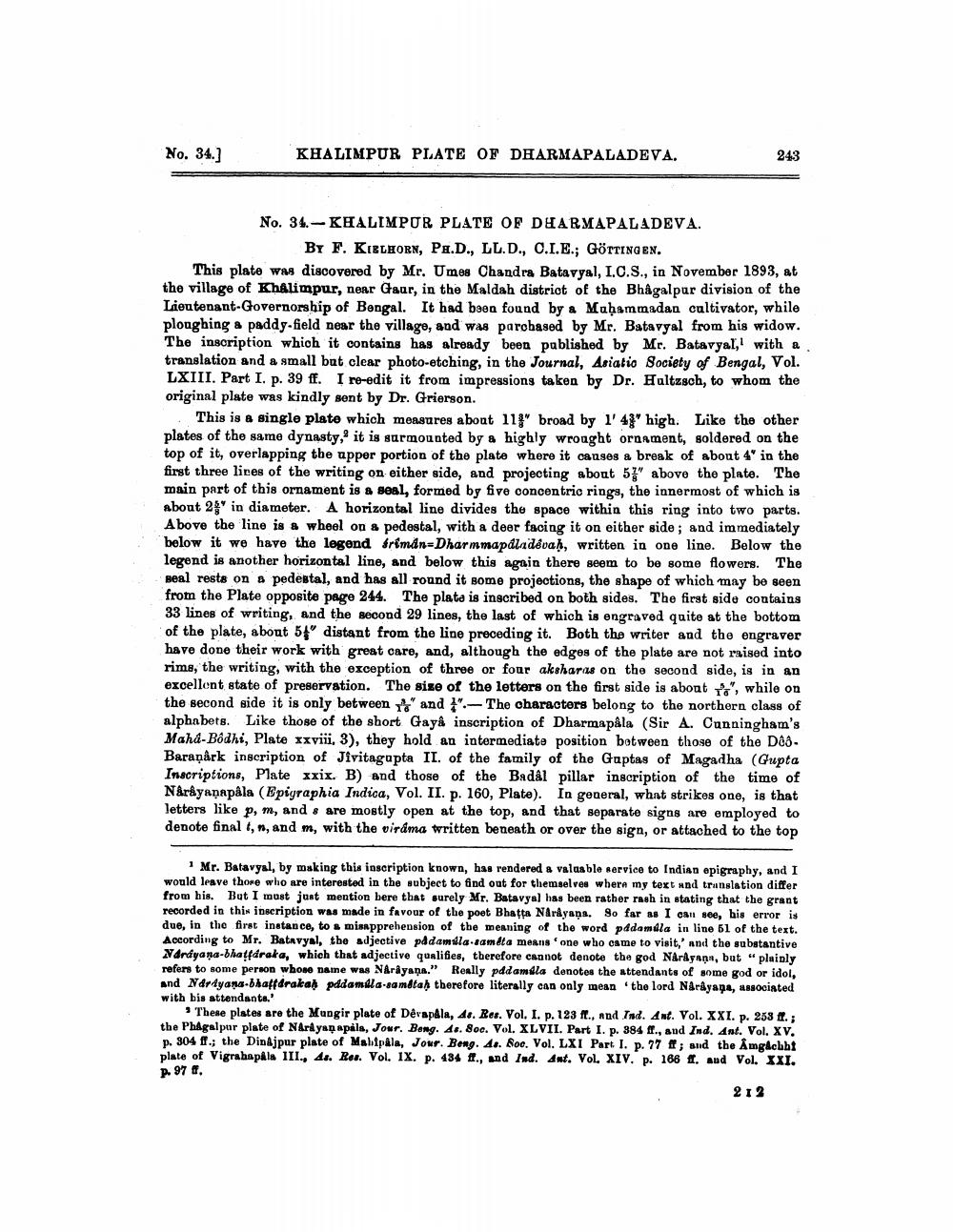________________
No. 34.]
KHALIMPUR PLATE OF DHARMAPALADEVA.
243
No. 34. - KHALIMPUR PLATE OF DHARMAPALADEVA.
BY F. KIELHORN, PA.D., LL.D., C.I.E.; GÖTTINGEN. This plate was discovered by Mr. Umes Chandra Batavyal, I.C.S., in November 1893, at the village of KhAlimpur, near Gaur, in the Maldah district of the Bhagalpur division of the Lieutenant-Governorship of Bengal. It had been found by a Muhammadan cultivator, while ploughing a paddy-field near the village, and was parobased by Mr. Batavyal from his widow. The inscription which it contains has already been published by Mr. Batavyal, with a translation and a small bat clear photo-etching, in the Journal, Asiatic Society of Bengal, Vol. LXIII. Part I. p. 39 ff. I re-edit it from impressions taken by Dr. Haltzsch, to whom the original plate was kindly sent by Dr. Grierson.
This is a single plate which measures about 114" broad by 1' 43' high. Like the other plates of the same dynasty, it is surmounted by a highly wrought ornament, soldered on the top of it, overlapping the upper portion of the plate where it causes a break of about 4' in the first three lives of the writing on either side, and projecting about 5%" above the plate. The main part of this ornament is a seal, formed by five concentric rings, the innermost of which is about 2' in diameter. A horizontal line divides the space within this ring into two parts. Above the line is & wheel on & pedestal, with a deer facing it on either side ; and immediately below it we have the legend frimin=Dharmmapaladevah, written in one line. Below the legend is another horizontal line, and below this again there seem to be some flowers. The seal rests on a pedestal, and has all round it some projections, the shape of which may be seen from the Plate opposite page 244. The plata is inscribed on both sides. The first side contains 33 lines of writing, and the second 29 lines, the last of which is engraved quite at the bottom of the plate, about 51' distant from the line preceding it. Both the writer and the engraver have done their work with great care, and, although the edges of the plate are not raised into rims, the writing, with the exception of three or four aksharas on the second side, is in an excellent state of preservation. The size of the letters on the first side is about Pa', while on the second side it is only between " and " The characters belong to the northern class of alphabets. Like those of the short Gaya inscription of Dharmapåla (Sir A. Cunningham's Maha-Bodhi, Plate xxviii, 3), they hold an intermediate position between those of the D26. Baranårk inscription of Jivitagapta II. of the family of the Gaptas of Magadha (Gupta Inscriptions, Plate xxix. B) and those of the Badal pillar inscription of the time of Narayannpåla (Epigraphia Indica, Vol. II. p. 160, Plate). In general, whnt strikes one, is that letters like p, m, and 8 are mostly open at the top, and that separate signs are employed to denote final, n, and m, with the virama written beneath or over the sign, or attached to the top
1 Mr. Batavgal, by making this inscription known, has rendered a valuable service to Indian epigraphy, and I would leave thore who are interested in the subject to find out for themselves where my text and translation differ from his. But I must junt mention bere that surely Mr. Batavyal has been rather rash in stating that the grant recorded in this inscription was made in favour of the poet Bhatta Nardyaņa. So far as I can see, his error is due, in the first instance, to s misapprehension of the meaning of the word pddamdla in line 51 of the text. According to Mr. Batavyal, tbe adjective pddamilla sam da means one who came to visit,' and the Ndrágana-bhatfdraka, which that adjective qualities, therefore cannot denote the god Narayan, but "plainly refers to some person whose name was Narayana." Really pddamila denotes the attendants of some god or idol, and Nardyana-bhaffdrakah padamila-sandtah therefore literally can only mean the lord Narayage, associated with bis attendants.
These plates are the Mungir plate of Dêrapala, 4s. Res. Vol. I. p. 123 f., And Ind. Ant. Vol. XXI. p. 253 f.; the Phagalpur plate of Narayanapals, Jour. Bong. As. Soc. Vol. XLVII. Part I. p. 384 ff., and Ind. Ant. Vol. XV. p. 304 ff.; the Dinajpur plate of Mahipala, Jour. Beng. 41. Roo. Vol. LXI Part I. p. 77 ff; and the Amg&cbb plate of Vigrahapkla III., 4s. Res. Vol. IX. p. 434 f., and Ind. Ant. Vol. XIV. p. 186 . and Vol. XXI. p. 97 .
212




